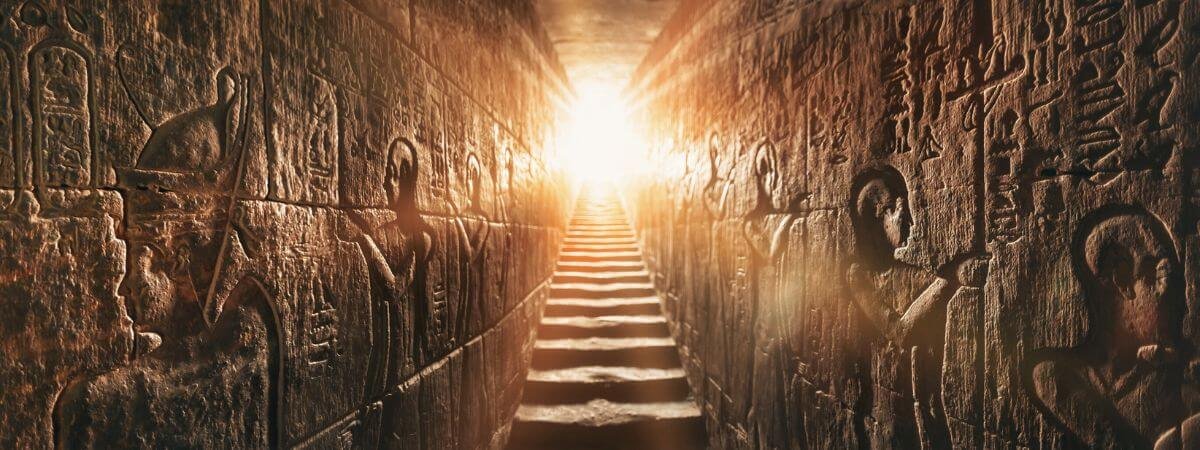Top 15 Ancient Egyptian Symbols and Their Hidden Meanings
Let us take you on a spellbinding journey through the ages as we reveal the hypnotic ancient egyptian symbols. The Nile River civilization’s symbolic language tells a tale of birth, death, and the supernatural influences that molded their beliefs; it also leaves an everlasting impression on history. Come with us as we investigate 15 fascinating symbols that the ancient Egyptians used in their art, religion, and everyday lives.
1. Ankh: The Key to Immortality in Ancient Egyptian Symbols
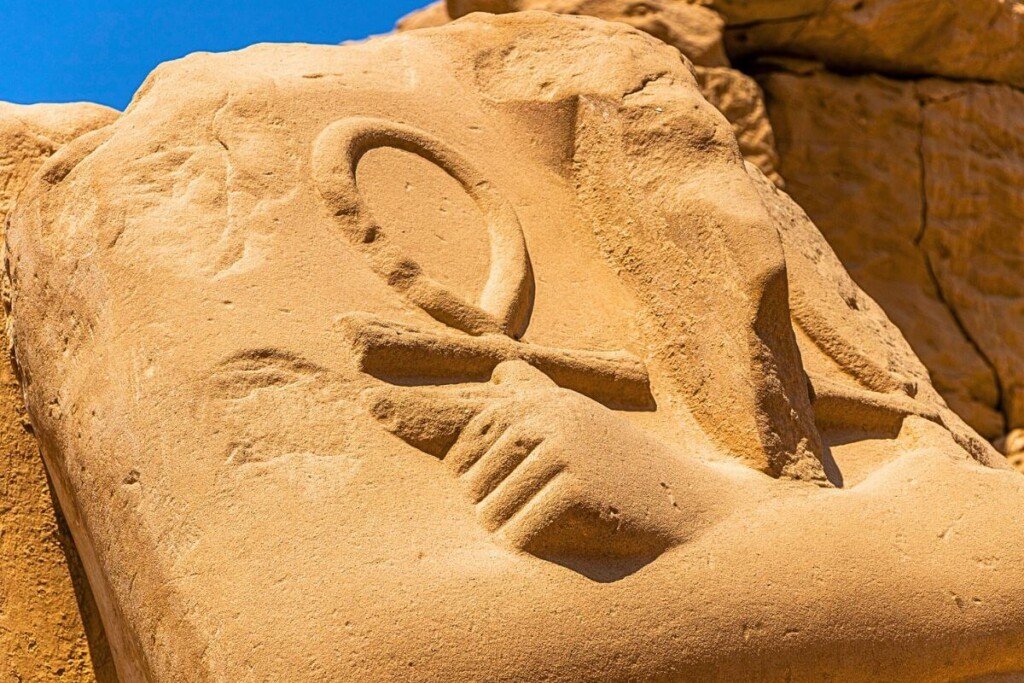
At the heart of ancient Egyptian symbolism lies the Ankh, a symbol resembling a cross with a loop at the top. Known as the “Key of Life,” the Ankh represents the eternal cycle of life and death. Unraveling its mysteries takes us deep into the beliefs of ancient Egyptians, where the promise of immortality was a guiding force.
Here are some key things to know about the Ankh:
- Symbol of life: First and foremost, the Ankh represents life in all its physical and spiritual forms. It was often depicted in the hands of gods and pharaohs, symbolizing their immortality and divine power.
- Eternal life: For the ancient Egyptians, death wasn’t the end but a transition to the afterlife. The Ankh, therefore, also signified eternal life, ensuring the deceased’s journey into the next world.
- Air, water, and sun: The shape of the Ankh is believed to represent the three elements essential for life: the loop for the sun, the crossbar for air, and the vertical bar for water.
- Union of opposites: The Ankh can also be seen as a symbol of the union of opposites, such as male and female, heaven and earth, and physical and spiritual realms.
Dive into Egypt’s stunning beaches. Reserve today and book Egypt Shore Excursions!
2. Eye of Horus: in ancient Egyptian symbols,[ Wadjet’s Watchful Gaze]
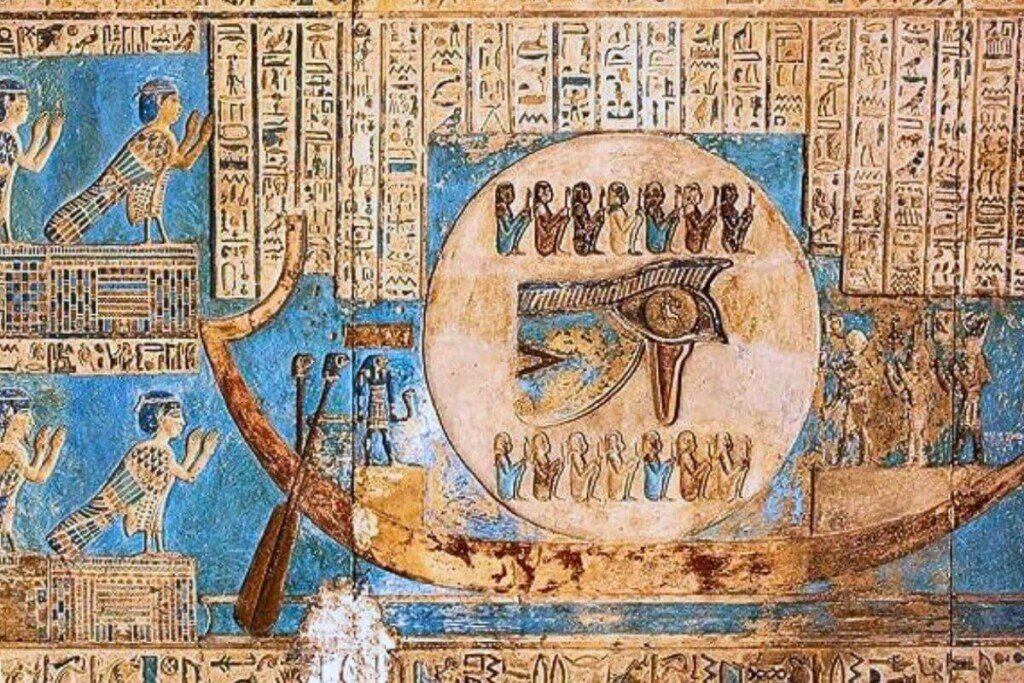
The Eye of Horus, also known as the Wedjat or Udjat, is one of the ancient egyptian symbols of religion’s most recognizable and enduring symbols. It represents a stylized eye with distinctive markings; the Eye of Horus held a plethora of meanings for the ancient Egyptians:
- Protection: It was believed to ward off evil, illness, and negative forces. Amulets and jewelry depicting the Eye of Horus were commonly worn for protection.
- Healing: The restoration of Horus’s eye symbolized the power of healing and regeneration. The symbol was used in medical practices and funerary rites.
- Royal power: The Eye of Horus was associated with the Pharaoh, representing their divine authority and connection to the gods.
- Fractions and measurement: The bits associated with the eye’s parts were used in ancient Egyptian mathematics and medicine.
- The moon and rebirth: The waxing and waning of the moon were likened to the injury and restoration of the eye, symbolizing cycles of death and resurrection.
The Eye of Horus remains a powerful art, jewelry, and popular culture symbol. Its enduring legacy speaks to its timeless message of protection, healing, and the hope for wholeness.
Journey to Egypt’s Hidden Gems: Click to Explore Luxury Egypt Tours!
3. Scarab Beetle: ancient Egyptian symbols of Regeneration
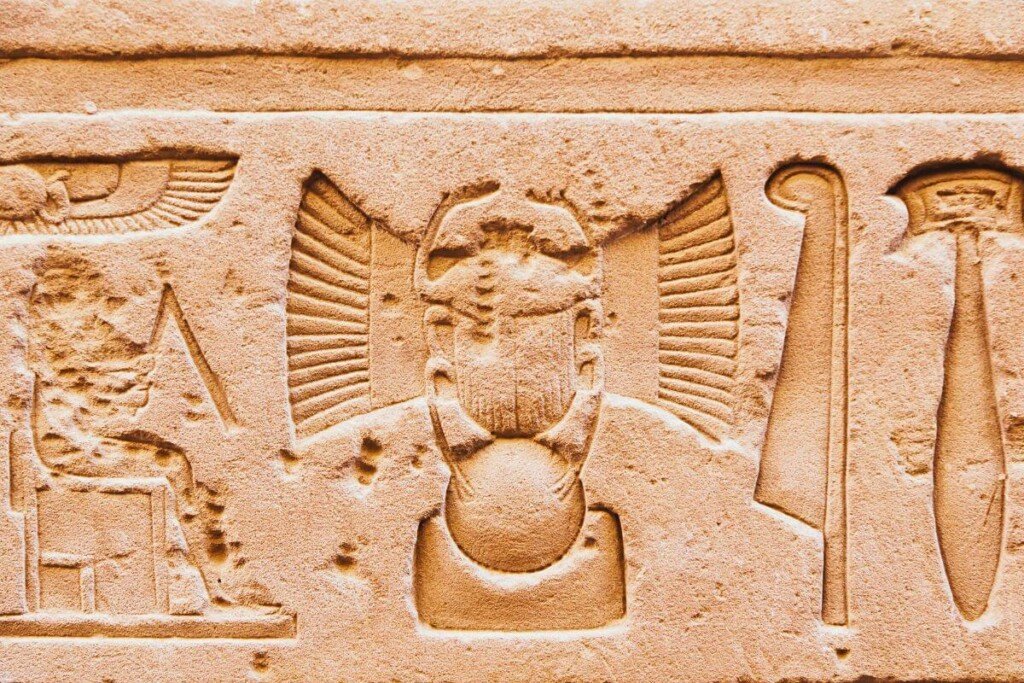
The scarab beetle has been a powerful symbol of regeneration for millennia, particularly in ancient Egyptian symbol culture. It’s truly fascinating how the humble dung beetle became such a deeply meaningful icon.
Here are some reasons why the scarab beetle embodies regeneration:
- Connection to the sun god: The Egyptians associated the scarab with Khepri, the sun god depicted as a scarab-headed figure. Khepri represented the dawn and the rebirth of the sun each morning, linking the scarab even more closely to the concept of regeneration.
- Amulets and funerary art: Scarab amulets were widely used by the living and the dead in ancient Egypt. The living wore them for protection and to ensure eternal life, while the dead were buried with them to aid their journey into the afterlife and guarantee their resurrection.
The scarab beetle’s symbolic meaning wasn’t confined to ancient Egypt. In other cultures, it represents transformation, resilience, and overcoming challenges. Even today, scarabs are used in jewelry and art, reminding us of this powerful symbol of regeneration.
Embark on a Nile Cruise—Book Your Dream Egypt Nile Cruises!
4. Djed Pillar: Stability in Symbolism
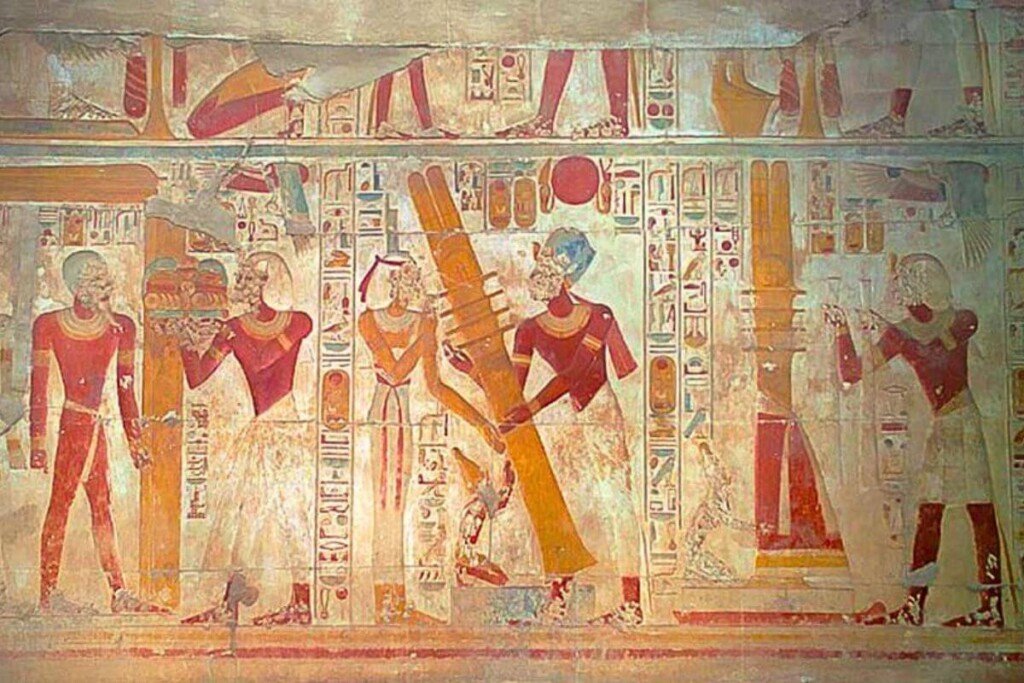
One of the most recognizable symbols of ancient Egyptian religion is the Djed pillar, or spine, of Osiris. Tombs, temples, and amulets portray this pillar-like structure with four horizontal crossbars. Its complex symbolism includes Egyptian worldview elements like:
- Stability and permanence: The DJ’s solidity symbolizes permanency. It represented the universe’s order as a pillar holding up the sky. The Djed conveyed the deceased’s longing for everlasting life.
- Osiris and the afterlife: The Djed is linked to Osiris, the underworld and resurrection deity. Like his backbone, it symbolizes his strength and capacity to endure death. Djed in tombs illustrated the deceased’s link to Osiris and hope for reincarnation after death.
- Creation and Ptah: Ptah, the creation deity, is linked to the Djed pillar. Sometimes called “the Djed,” Ptah symbolized the universe’s creative energies. In temples, the Djed illustrates Ptah’s role in shaping and preserving the world.
- Duality and balance: The Djed’s four horizontal crossbars symbolize life and death, good and evil, or the physical and spiritual worlds. This perspective stresses the Egyptians’ understanding of the universe’s interconnection and equilibrium.
- Protection and magical power: The living and dead wore the Djed as an amulet. It was supposed to defend against evil and secure hereafter safety. Djeds were often used in spells and funeral inscriptions, enhancing their potency.
5. Sphinx: Guardian of Secrets in Ancient Egyptian symbols
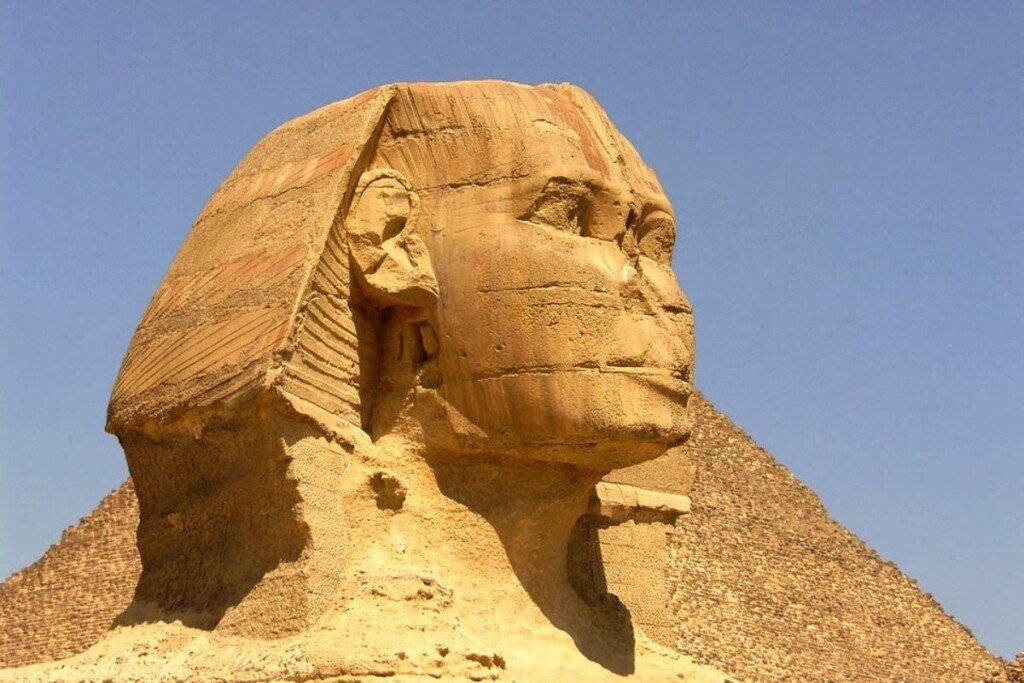
The Sphinx, Guardian of Secrets! Its name conjures images of ancient egyptian symbols, sun-baked sand, towering pyramids, whispers of forgotten knowledge, and riddles lost to time.
Here are some ways to think about the Sphinx, Guardian of Secrets:
- The Historical Guardian: In silence for millennia, the Sphinx has seen civilizations grow and fall, whispering untold secrets. It guards history with its aged characteristics and old culture.
- The Riddle Keeper: Oedipus’ puzzling Sphinx riddle is perhaps its most renowned feature. This complex puzzle illustrates the Sphinx’s function as a knowledge keeper, challenging those who seek its insight to prove themselves.
- The Gatekeeper of the Underworld: With its lion body and human head, the Sphinx guards the underworld’s entrance at the crossroads of life and death. It symbolizes the afterlife, rebirth, and mysteries beyond.
- The Symbol of Power: The magnitude and magnificence of the Sphinx reflect the pharaohs who erected it. It shows their aspiration to reach the sky and defy time.
Secure Your Egypt Desert Safari Tours!
6. Lotus Flower: Blooming from Chaos
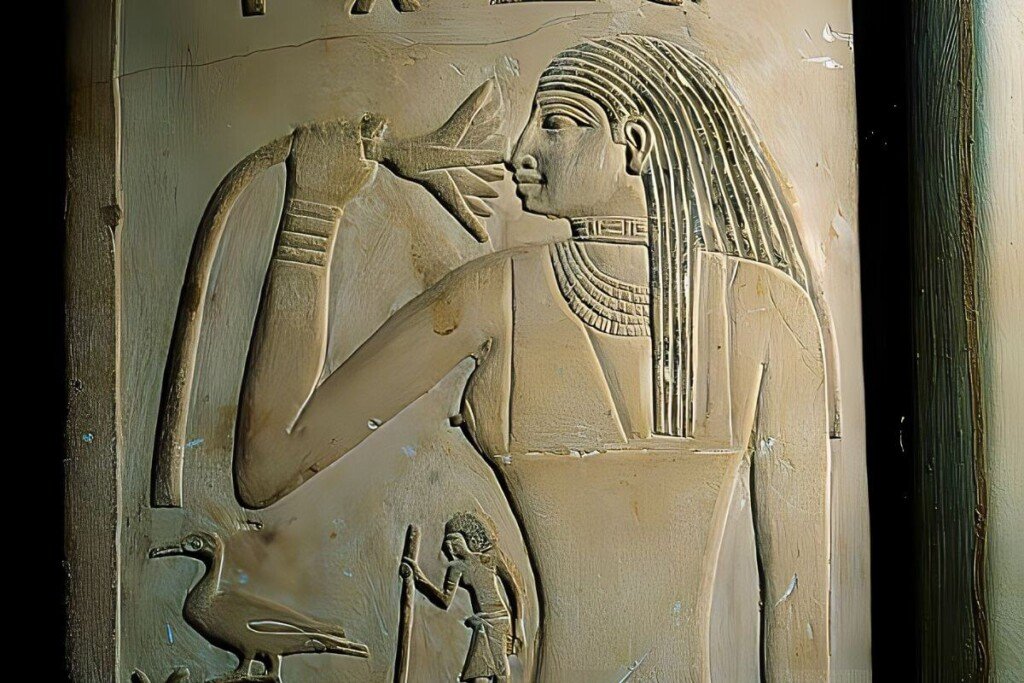
Delve into the symbolism of the Lotus Flower, an exquisite blossom emerging from murky waters. Representing rebirth and purity, the lotus encapsulates the ancient Egyptian belief in creation arising from chaos. Here are some key aspects of its symbolism:
- Purity: A symbol of inner cleanliness and spiritual enlightenment, the lotus rises from dirty water with its pure petals. It remains spotless despite its surroundings.
- Rebirth and transformation: Lotuses signify life, death, and rebirth since they close at night and blossom again in the morning—the capacity to overcome obstacles and become stronger, like converting darkness into light.
- Strength and resilience: The lotus flower thrives in muddy waters. Its delicate beauty represents the ability to find light and development in difficult conditions and endure suffering with grace.
7. Winged Sun Disk: Divine Kingship Unveiled

With its magnificent wings and bright orb, the Winged Sun Disk is a powerful symbol with a long history and many meanings. In ancient egyptian symbols, it had religious and regal significance.
Here’s a deeper dive into the symbolism of the Winged Sun Disk:
- Divine Power and Protection: The Egyptians worshipped Ra, the sun, as a life-giving deity. The disk represents heavenly power, light, and order. The falcon or vulture wings symbolize protection, speed, and flight above our world. Flight relates the disk to holy transcendence.
- Royal Authority and Legitimacy: The Winged Sun Disk appeared on Pharaonic tombs, temples, and jewelry. This linked the Pharaoh to Ra, legitimizing their reign and giving them divine power. The wings might symbolize the Pharaoh’s position as a mediator between gods and humanity, bringing celestial favors to the people.
- The Soul and Afterlife: The winged sun disk symbolized Egyptian afterlife beliefs. It represented the soul’s departure to the heavenly world and joining Ra after death. For eternal success, Maat (truth, justice, and cosmic order), virtuous acts, and clean thoughts may be needed.
The Winged Sun Disk generally symbolizes divine might, protection, and transcendence. Its long history throughout civilizations shows its universality and deep affinity for the sun.
Discover Egypt’s ancient Wonders! Book your Egypt Vacation Packages Now!
8. Uraeus: Cobra of Divine Authority

Uncoil the symbolism of the Uraeus, the cobra representing divine authority. Learn about its association with the goddess Wadjet and its presence on the crowns of pharaohs. It could refer to two distinct entities:
The Uraeus:
This is the most typical interpretation given that the Uraeus is the iconic rearing cobra that pharaohs wore on their crowns. As I mentioned earlier, it represents:
- Protection: The Uraeus embodied the goddess Wadjet, protector of Lower Egypt and the Pharaoh. Its raised hood and ready-to-strike pose symbolized fierce defense against enemies.
- Divinity: The Uraeus linked the Pharaoh to the gods, particularly Ra, the sun god. It signified the Pharaoh’s semi-divine status and cosmic power.
- Sovereignty: The Uraeus marked the Pharaoh as the supreme ruler, wielding absolute authority over the land and its people.
9. Ma’at Feather: Weighing Truth in the Afterlife
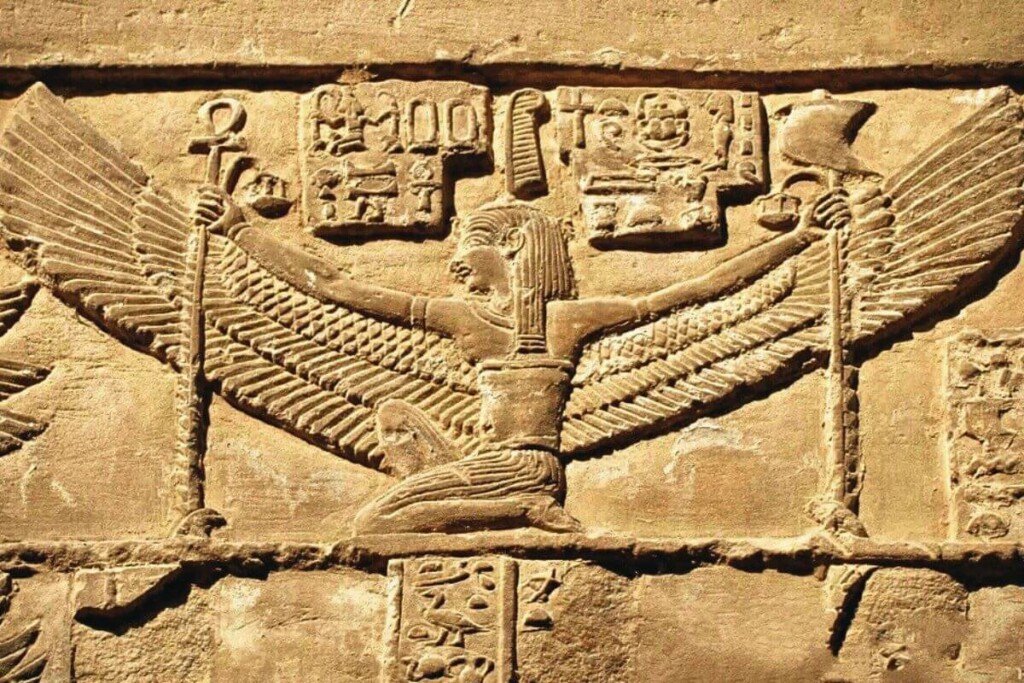
The Ma’at Feather, representing truth and justice, was central to the judgment of the deceased in the afterlife. The heart was weighed against this feather on the cosmic scales of Ma’at.
Here is a deeper dive into the rich symbolism of the Maat feather:
- Truth and Justice:
The main meanings of the Maat feather are truth, justice, and cosmic order. The ancient Egyptians valued “Maat,” which included cosmic equilibrium, morality, and justice. The feather symbolizes fairness, honesty, and correct behavior. Pharaohs represented their responsibility to uphold these beliefs by wearing the Maat feather.
- Weighing of the Heart:
Maat feathers were vital to Egyptian afterlife beliefs. The Heart Weighing Ceremony The departed entered the afterlife paradise if their heart was lighter than their feather, indicating a Maat-following life. Sinning and having a heavy heart led to underworld damnation.
- Cosmic Order and Harmony:
Maat feathers signified cosmic order and harmony beyond morality. It symbolized the delicate equilibrium between conflicting forces, the universe’s fundamental principles, and universalism. Keep Maat to keep the universe running smoothly and avert chaos.
10. Shen Ring: The Infinite Loop of Eternity

The Shen Ring, a looped rope with no beginning or end, symbolizes eternity. Worn as an amulet, it was believed to provide protection and ensure everlasting existence in the afterlife.
- Meaning and Symbolism:
Eternal Protection: The Shen Ring, the cartouche, represents lasting protection. Its circular shape, with no beginning or end, signifies infinity and everlasting life.
- Sun and Creation: The loop often encloses the sun symbol, emphasizing the eternal nature of the universe and the cycle of creation and rebirth.
- Divine Protection: Gods like Horus and Nekhbet are often depicted holding the Shen Ring over pharaohs and other figures, offering them divine protection.
- Encirclement and Security: Encirclement symbolized protection in ancient Egypt, hence the connection between the Shen Ring and security.
- Amulets and Jewelry: Shen rings were worn as amulets for personal protection and were also incorporated into jewelry and decorative objects.
11. Cartouche: Inscribing Royalty

The Cartouche, an oval shape enclosing hieroglyphs, was a royal symbol. It contained the names of pharaohs and esteemed individuals, symbolizing their eternal significance in the cosmic order.
Here are some key things to know about the cartouche:
- Purpose: The cartouche served two main goals:
- Identification: It identified the person whose name was written inside.
- Protection: It was believed to protect the name and the person it belonged to from evil spirits and ensure their safe passage into the afterlife.
- Symbolism: The shape of the cartouche is thought to represent several things:
- The sun: The oval shape is similar to the sun, a symbol of the divine in ancient Egypt.
- Usage: Cartouches were commonly found on monuments, tombs, temples, jewelry, and other objects.
12. Crook and Flail: Emblems of Pharaonic Authority in Ancient Egyptian Symbols
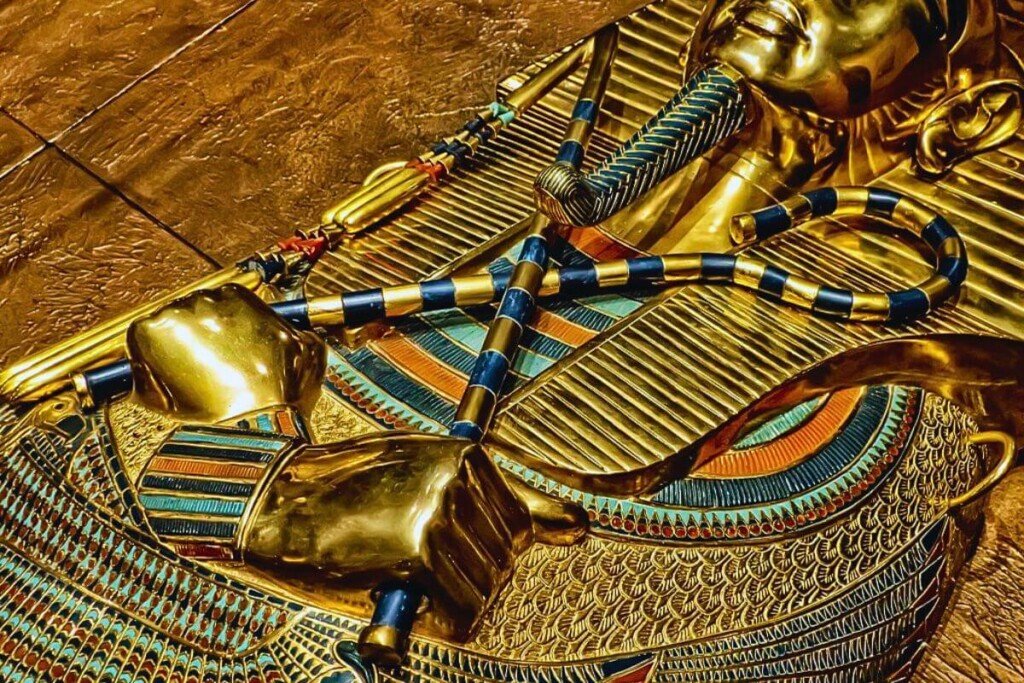
The Crook and Flail, symbols of shepherd and ruler, were emblems of pharaonic power. Held by Osiris and later by pharaohs, they represented divine authority and leadership responsibilities.
The crook:
Shaped like a shepherd’s staff, it represented the king’s role as protector and guide of his people. Just as a shepherd tends to his flock, the Pharaoh is responsible for the well-being of his subjects. Its curved form also evoked the image of the fertile crescent moon, symbolizing prosperity and abundance.
The flail:
Together, the crook and flail embodied the duality of pharaonic power:
- Benevolence and strength: The crook’s gentle curve contrasted with the flail’s potential for force, showcasing the king’s capacity for care and decisive action.
- Life and death: The crook associated with the crescent moon and fertility linked the Pharaoh to the life cycle, while the flail, used in preparing offerings for the deceased, connected him to the realm of the dead.
13. Tyet: The Knot of Eternal Life
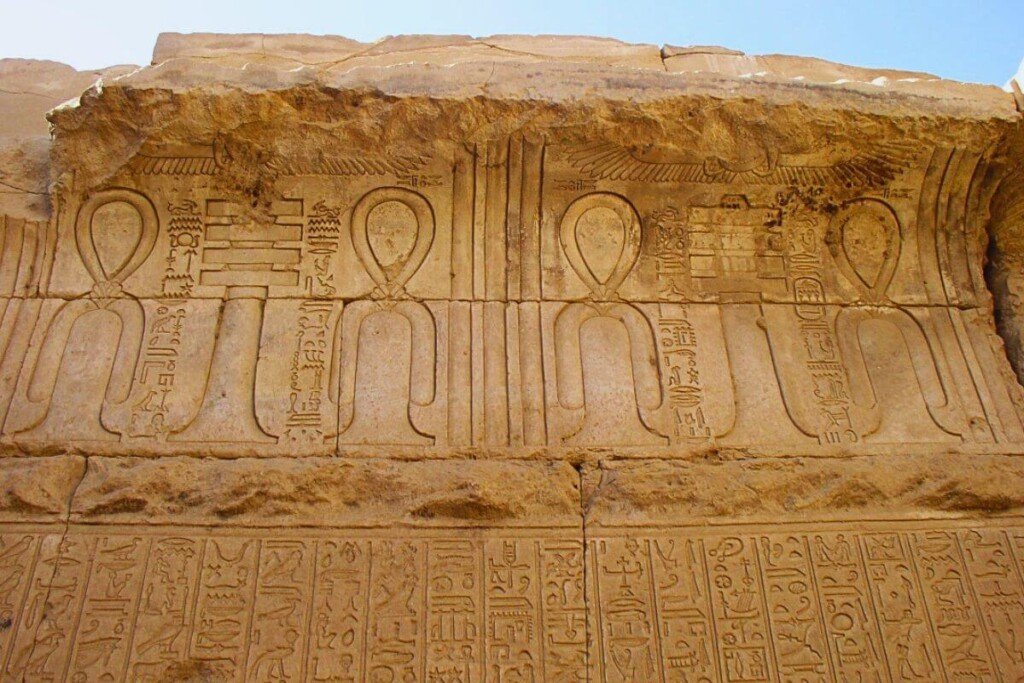
The tyet, also known as the Knot of Isis or the Blood of Isis, is a fascinating ancient Egyptian symbol with a rich history and diverse interpretations. Here’s what we know about it:
- Appearance:
The tyet resembles a knot, often depicted as a fabric loop tied with two loose ends. It’s sometimes shown adorned with beads or tassels.
- Meaning and Significance:
The tyet’s exact meaning remains debated, but it’s widely associated with the goddess Isis, a powerful figure in Egyptian mythology known for her magic, healing, and protective qualities. Some interpretations link the tyet to life, protection, rebirth, and magic. Its resemblance to the ankh, another prominent symbol of life, reinforces this connection.
- Uses:
The tyet appeared in various contexts throughout Egyptian history. It was frequently carved onto amulets, jewelry, and religious objects, serving as a protective charm for the living and the dead. It adorned the walls of temples and tombs, often alongside other significant symbols like the ankh and the djed pillar.
- Evolution and Legacy:
The tyet’s origins likely predate its association with Isis. Early examples, dating back to the First Dynasty, suggest it might have initially represented a practical object like a bandage. Over time, it evolved into a powerful symbol, deeply intertwined with Isis’s identity and significance. Even after Egypt’s conversion to Christianity, the tyet’s influence persisted, influencing early Christian symbols like the Virgin Mary’s girdle.
Don’t miss checking out our article:
Explore Egypt Travel Tips to make the most of your trip.
Discover the Best Time to Travel to Egypt and book your journey.
14. Ba Bird: Winged Messenger of the Soul
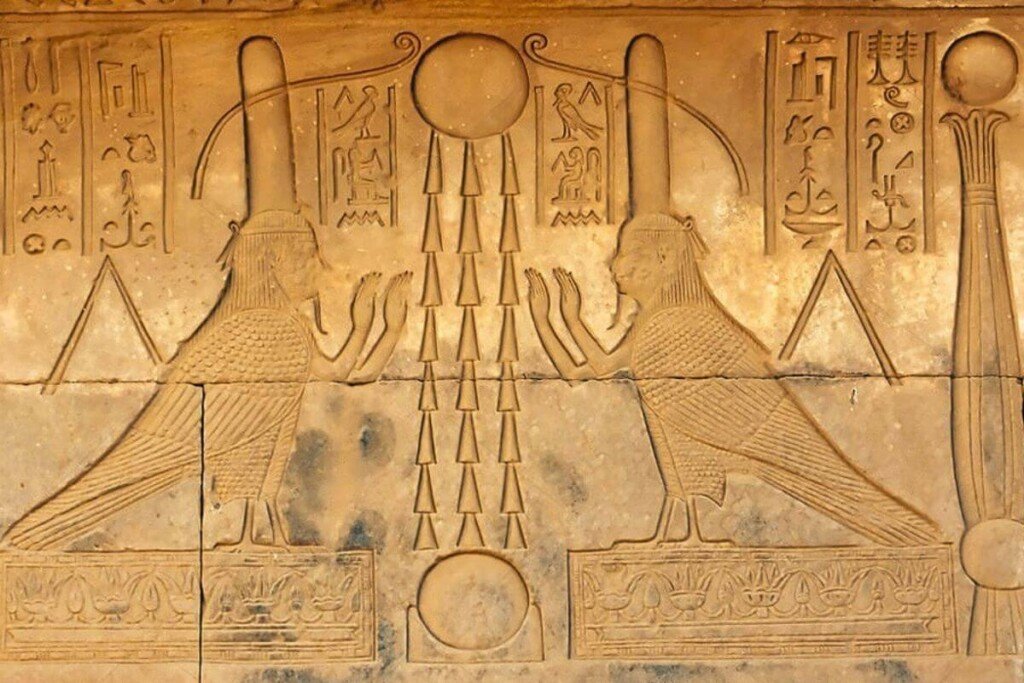
The Ba bird, with its majestic wings and a captivating human head, is a powerful symbol in ancient Egyptian mythology. Let’s delve deeper into its significance, exploring its appearance, meaning, and presence in ancient Egyptian art.
- Appearance:
An elegant heron with a long, curved beak, a royal crested head, and slender, lengthened legs. The sleek design symbolizes the soul’s ethereality. The Atef crown, a unique mix of Upper and Lower Egypt’s white and crimson crowns, often features the Ba bird. This headgear symbolizes the afterlife’s union and divinity. In some artworks, the Ba bird holds an ankh or Shen ring, symbolizing life and eternity. These components highlight soul persistence.
- Significance:
One of the three soul components was the Ba, the Ka (life force), and the Akh. Consider Ba, the soul’s winged messenger, guiding the departed through the underworld and maybe reincarnating. Its mighty wings stood for the afterlife and the ability to fly. The Ba’s devotion to Ra reinforced their belief in immortality and the cycle of life and death. A golden falcon represented the Ba bird, Ra’s daily journey through the underworld.
- Presence in ancient Egyptian art:
Search tomb art for the Ba bird! These bright paintings showed the Ba perched on the mummies or elegantly over the corpse, symbolizing their immediate afterlife. In elaborate episodes in the Book of the Dead, the Ba bird interacts with deities and navigates the underworld. Illustrations guided and comforted the dying on their afterlife journey.
15. Sistrum: Musical Magic of Hathor
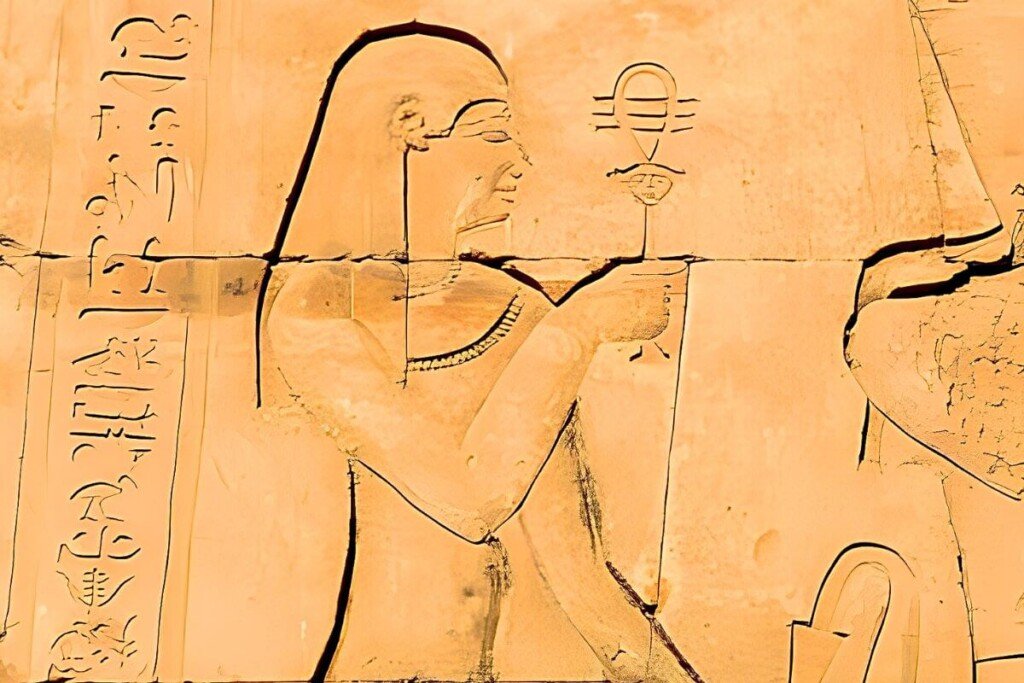
Experience the enchanting sound of the Sistrum, a musical instrument associated with the goddess Hathor. Dive into the religious ceremonies where its melodic tones played a vital role.
Sistrum and ancient egyptian symbols
- Hathor, Goddess of Love and Music: Hathor, the goddess of love, music, dancing, joy, and fertility, is the sistrum’s main symbol. It resembled a cow’s head, like Hathor’s headgear, signifying her maternity and creation.
- Cosmic Harmony: Like the moon’s cycle, a U-shaped sistrum symbolizes cosmic equilibrium and the universe’s rhythm. Jingling discs occasionally included cats, another Hathor, and a moon cycle sign.
- Protection and Warding: The sound of the sistrum was supposed to ward off evil and bring luck. Rituals utilized it to fight against negativity and bless dwellings with Hathor’s goodness.
- Fertility and Abundance: The sistrum’s agricultural importance was linked to Hathor, the fertility goddess. Its song was supposed to enhance Nile floods and abundant crops.
- Connection with the Divine: The sistrum connected with gods and goddesses, notably Hathor. Music connects the terrestrial and divine realms.
Join us for adventure and discovery on our Egypt Day Tours.
Places where you can see ancient Egyptian symbols
Ancient Egyptian symbols are ubiquitous throughout Egypt, from the grand monuments and temples to smaller artifacts and jewelry.
- The Pyramids: The Pyramid of Giza, for example, features the Eye of Horus symbol on its sarcophagus and the cartouches of Pharaoh Khufu.
- The Great Sphinx: The Sphinx is a colossal lion with a human head, symbolizing strength and wisdom. Its body is covered with hieroglyphs, including the ankh (symbol of life) and the shen (symbol of eternity).
- The Karnak Temple: This vast complex in Luxor is dedicated to the god Amun and features walls adorned with thousands of hieroglyphs depicting gods, pharaohs, and religious scenes.
- The Valley of the Kings: Located near Luxor, this cemetery houses the tombs of several pharaohs, including Tutankhamun. The walls of these tombs In The Valley of the Kings are decorated with intricate paintings and hieroglyphs, showcasing a wealth of ancient Egyptian symbols.
- The Egyptian Museum in Cairo: This world-renowned museum in cairo houses an extensive collection of Egyptian artifacts, including mummies, sarcophagi, statues, and jewelry adorned with various symbols.
Conclusion;
As we conclude our journey through the rich tapestry of ancient Egyptian symbolism, we find ourselves immersed in a world where every hieroglyph and every artifact tells a story of belief, ritual, and cosmic forces. The symbols of ancient Egypt transcend time, inviting us to explore the mysteries that shaped a civilization that flourished along the banks of the Nile.
Learn more about ancient Egypt from Wikipedia.

